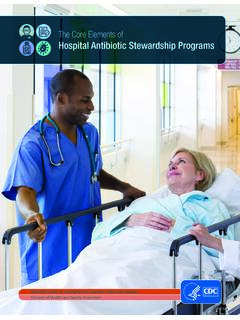Transcription of Hospital Infection Prevention and Control Guidelines
1 Hospital . Infection . Prevention AND. Control . Guidelines . 1. CONTENTS. Chapters Page 1. Introduction 3. 2. Hospital Infection Control Committee 4. 3. Surveillance of Healthcare Associated Infections 7. 4. Hospital Outbreak Management 10. 5. Infection Control Processes 13. - Standard Precautions - Hand Hygiene - Personal Protective Equipment 6. Prevention And Control of Healthcare Associated Infections 21. - Catheter-associated Urinary Tract Infections - Surgical Site infections - Ventilator associated Pneumonia - Catheter related blood stream Infections 7.
2 Cleaning, Disinfection and Sterilization 31. 8. Isolation Precautions 38. 9. Antimicrobial Policy and Antimicrobial stewardship 44. 10. Biomedical Waste Management 51. 11. Occupational Health and Safety 58. 2. 1. INTRODUCTION. Healthcare-associated Infection (HCAI) is one of the most common complications of health care management. It is a serious health hazard as it leads to increased patients' morbidity and mortality, length of Hospital stay and the costs associated with Hospital stay. Effective Infection Prevention and Control is central to providing high quality health care for patients and a safe working environment for those that work in healthcare settings.
3 It is important to minimize the risk of spread of Infection to patients and staff in Hospital by implementing good Infection Control programme. This document outlines the broad principles and practices of Infection Control that are essential for the Prevention and management of Infection . The following Hospital Infection Control Policies are needed to be framed and practiced and monitored by the Hospital Infection Control Team (HICT) and Hospital Infection Control Committee (HICC). 1. Guidelines for Prevention & Control of infections 2.
4 Antimicrobial policy 3. Surveillance policy 4. Disinfection policy 5. Isolation policy 6. Policy for investigation of an outbreak of Infection The overall aim of this document is to provide evidence based information in the Prevention and Control of Infection . It is relevant to all staff including doctors, nurses, other clinical professionals and managers working in the Hospital . This document will be updated as and when required. 3. 2. Hospital Infection Control . PROGRAM. P revention of HCAI in patients is a concern of everyone in the facility and is the responsibility of all individuals and services providing health care.
5 Risk Prevention for patients and staff must be supported at the level of senior administration. The role of the Hospital Infection Control committee (HICC) is to implement the annual Infection Control programme and policies. Commitment towards Maintenance of Surveillance over HCAIs. Develop a system for identifying, reporting, analyzing, investigating and controlling HCAIs. Develop and implement preventive and corrective programs in specific situations where Infection hazards exist. Advice the Medical Superintendent on matters related to the proper use of antibiotics, develop antibiotic policies and recommend remedial measures when antibiotic resistant strains are detected.
6 Review and update Hospital Infection Control policies and procedures from time to time. Help to provide employee health education regarding matters related to HCAIs. HICC shall meet regularly - once a month and as often as required. The Committee is responsible for establishing and maintaining Infection Prevention and Control , its monitoring, surveillance, reporting, research and education. 4. Infection Control Committee The Committee is an integral component of the patient safety programme of the health care facility, and is responsible for establishing and maintaining Infection Prevention and Control , its monitoring, surveillance, reporting, research and education.
7 This committee should include wide representation from all relevant disciplines or departments in the facility. The committee has one elected chairperson who is the Hospital administrator or a person who has direct access to the head of the Hospital . Structure i. Chairperson: Head of the Institute (preferably). ii. Member Secretary: Senior Microbiologist iii. Members: Representation from Management/Administration (Dean/Director of Hospital ;. Nursing Services; Medical Services; Operations). iv. Relevant Medical Faculties v.
8 Support Services: (OT/CSSD, House- keeping/Sanitation, Engineering, Pharmacologist, Store Officer / Materials Department). vi. Infection Control nurse (s). vii. Infection Control officer Infection Control Team The Infection Control team should comprise of at minimum an Infection Control officer, a microbiologist (if ICO is not a microbiologist), and Infection Control nurse . ICT takes daily measures for the Prevention and Control of Infection in Hospital . 5. Responsibilities of the Infection Control Team Develop a manual of policies and procedures for aseptic, isolation and antiseptic techniques.
9 Carry out targeted surveillance of HAIs, data analysis for presentation in HICC meeting and take corrective steps Advise staff on all aspects of Infection Control and maintain a safe environment for patients and staff. Supervise and monitor cleanliness and hygienic practices Oversee sterilization and disinfection and monitor the use and quality Control of disinfectants Advise management of at risk patients and supervision of isolation procedures. Investigate outbreaks of Infection and take corrective measures for Control and Prevention of outbreak.
10 Waste management Provide relevant information on Infection problems to management. Assist in training of all new employees as to the importance of Infection Control and the relevant policies and procedures. Organize regular training programme for the staff to ensure implementation of Infection Control practices Audit Infection Control procedures and antimicrobial usage Monitors Health care workers safety Programme. 6. 3. SURVEILLANCE OF HEALTHCARE. ASSOCIATED INFECTIONS. Introduction Surveillance is one of the most important components of an effective Infection Control program.


